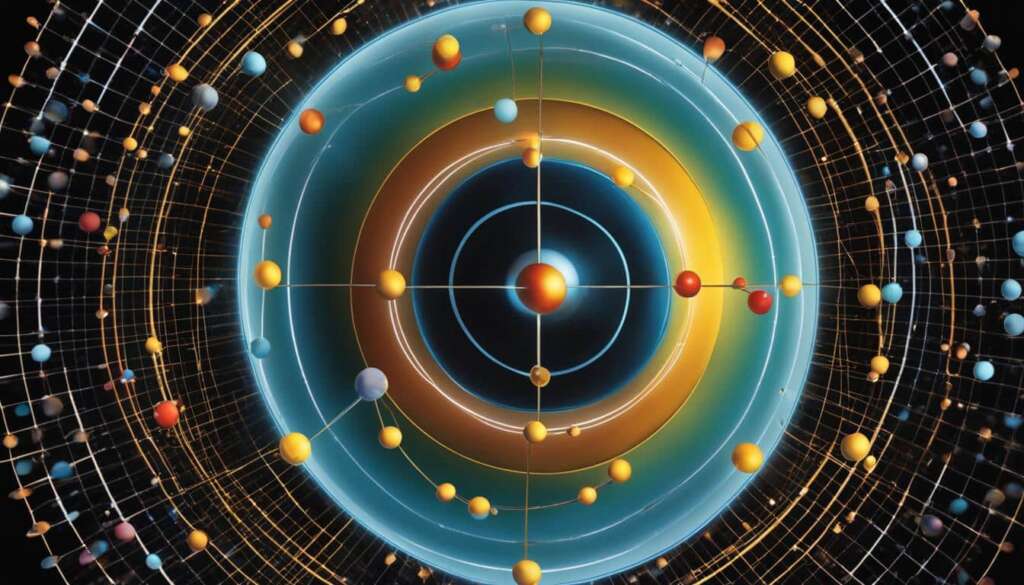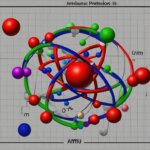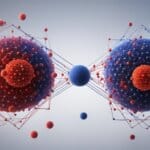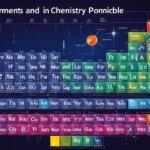Table of Contents
An atom is a fundamental particle of matter that defines a chemical element. It is made up of smaller subatomic particles, including protons, neutrons, and electrons. These components play a crucial role in defining the composition and characteristics of an atom.
The nucleus is the central region of an atom. It contains the positively charged protons and neutrally charged neutrons. Surrounding the nucleus are negatively charged electrons, which orbit around it in specific energy levels or shells.
The total mass of an atom, including the mass of protons, neutrons, and electrons, is referred to as its atomic mass or atomic weight. The atomic weight is measured in atomic mass units and can vary depending on the number of neutrons present in an atom.
Atoms are the basic building blocks of matter and can be found in all objects that have mass and occupy space. Understanding the composition of an atom is essential for grasping the intricate workings of our physical world.
The Composition of the Nucleus
The nucleus of an atom consists of two key components, namely protons and neutrons. Protons have a positive charge, while neutrons do not carry any charge. Together, protons and neutrons form the central core of the atom, known as the nucleus. This section explores the role of these particles in determining the properties and characteristics of an atom.
Protons, with their positive charge, play a vital role in defining the atomic number of an element. The atomic number corresponds to the number of protons present in the nucleus of an atom. It also determines the element’s position in the Periodic Table of Elements. For example, hydrogen, the simplest element, has an atomic number of 1, indicating the presence of one proton in its nucleus.
Alongside the atomic number, the number of protons also influences the characteristics of an atom. For instance, the number of protons determines whether an element is a gas, a metal, or a non-metal. These properties are directly linked to the arrangement and interactions between protons and electrons within the atom.
While the number of protons remains constant for a specific element, the number of neutrons can vary. Atoms that have the same number of protons but different numbers of neutrons are called isotopes. Isotopes have different atomic weights, reflecting the differing masses due to the varying number of neutrons. This characteristic can impact the stability and reactivity of isotopes, leading to distinct physical and chemical behaviors.
The Role of Electrons
Electrons, which have a negative charge, surround the nucleus of an atom. They occupy shells or orbitals of varying energy levels. The ground state is the energy level that an electron normally occupies, while an excited state occurs when an electron temporarily occupies an energy state greater than its ground state. Electrons can become excited by absorbing energy through processes such as the absorption of photons of light or collisions with other atoms or particles. However, they quickly return to their ground state, emitting a photon with the same energy as the absorbed one. The movement of electrons between shells is responsible for chemical reactions and the formation of molecules. If an atom gains or loses electrons, it becomes an ion and carries a positive or negative charge.
Energy Levels and Shells
Electrons in an atom are organized into designated energy levels, also known as shells or orbitals. These energy levels are represented by different quantum numbers, indicating the distance from the nucleus and the amount of energy an electron possesses. The electrons closest to the nucleus occupy lower energy levels, while those further away occupy higher energy levels. The arrangement of electrons within these shells follows the “Aufbau principle,” which states that electrons fill the lowest energy level available before moving on to higher levels.
Excited and Ground States
Electrons in an atom typically occupy their ground state, where they have their lowest possible energy. However, when an electron gains additional energy, often through the absorption of photons or collisions, it can temporarily transition to an excited state. In this excited state, the electron moves to a higher energy level. This excited state is unstable, and the electron quickly returns to its ground state, releasing the excess energy as a photon with the same energy as the absorbed one.
This process of absorption and emission of energy is crucial in many natural phenomena, such as the generation of light and the colors we perceive. For example, when electrons in a material absorb visible light, they transition to an excited state and then emit photons of specific energies, determining the color of the material.
The Role in Chemical Reactions
The movement of electrons between energy levels is central to chemical reactions. When atoms come into contact, their electrons can interact and either share or transfer energy. This exchange of electrons leads to the formation of new chemical bonds and the creation of molecules.
For instance, in the formation of water (H2O), two hydrogen atoms bond with an oxygen atom. The oxygen atom has six electrons in its outermost shell, while hydrogen atoms have one electron each. During the reaction, each hydrogen atom shares an electron with the oxygen atom, forming covalent bonds. This sharing of electrons allows the oxygen atom to complete its outer shell, fulfilling the octet rule. By sharing electrons, atoms achieve greater stability, resembling the electron configuration of noble gases.
In some cases, an atom may gain or lose electrons entirely, resulting in the formation of ions. This process, known as ionization, leads to the creation of positively or negatively charged ions. Ionization plays a vital role in various chemical processes, such as ionic bonding and electrolysis, where ions are involved.
| Energy Level | Maximum Number of Electrons | Shell notation |
|---|---|---|
| 1 | 2 | K |
| 2 | 8 | L |
| 3 | 18 | M |
| 4 | 32 | N |
The Unique Fingerprints of Elements
Each element possesses a distinctive arrangement of energy levels for its electrons, which determines the possible transitions between different orbitals.
When electrons in a particular atom transition back to lower energy levels from an excited state, they emit photons with energies that are characteristic of that specific element. This phenomenon enables scientists to identify the elements present in a gas sample or even in distant stars.
By analyzing the wavelengths of these emitted photons, known as atomic signatures, researchers can accurately determine the composition of various materials and study celestial objects.
This process of utilizing the energy levels, atomic signatures, and emitted photons is the foundation for the identification of elements in scientific investigations.
Example:
“The atomic signatures emitted by the sample indicated the presence of hydrogen, helium, and trace amounts of nitrogen.”
Atomic Signatures of Selected Elements
| Element | Atomic Signature (Wavelength) |
|---|---|
| Hydrogen | 656.28 nm (red) |
| Helium | 587.56 nm (yellow) |
| Nitrogen | 391.39 nm (violet-blue) |
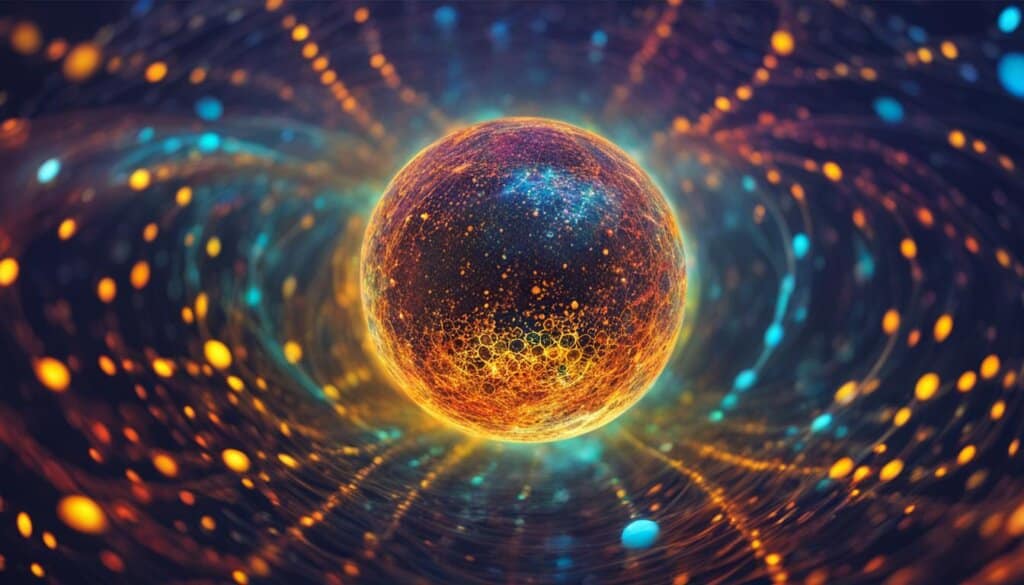
The History of the Atom
According to scientific theories, atoms were formed approximately 13.7 billion years ago in the first few minutes after the Big Bang. As the universe cooled and expanded, electrons and quarks – the smaller particles that make up protons and neutrons – began to form. Quarks then aggregated to create the nuclei of atoms. Over time, scientists developed various models to explain the structure of atoms. Physicists such as Niels Bohr and Ernest Rutherford proposed models in the early 20th century, which described electrons orbiting the nucleus in shells or circular paths. These models provided a foundation for our understanding of atomic physics.
| Scientist | Contributions |
|---|---|
| Niels Bohr | Proposed the planetary model of the atom where electrons orbit the nucleus in discrete energy levels or shells. |
| Ernest Rutherford | Discovered the atomic nucleus and proposed the nuclear model of the atom, with protons and neutrons concentrated in the nucleus. |
The Power of the Nucleus: Nuclear Fission and Energy
The nucleus of an atom is held together by the strong nuclear force, which overcomes the repulsive force between protons. When the bonds between particles in the nucleus are broken, a large amount of energy is released in a process called nuclear fission.
Nuclear fission is the splitting of uranium atoms, which is used in nuclear power plants to generate electricity. Uranium is chosen for fission because its atoms can easily split, releasing a significant amount of energy. This energy is harnessed to produce electricity, providing power to millions of homes and businesses.
Nuclear power is considered a clean energy source as it does not emit greenhouse gases that contribute to climate change. With the increasing concern for reducing carbon footprints, nuclear power is being explored as a viable option for IT data centers to minimize their environmental impact and carbon emissions.
By harnessing the power of the nucleus through nuclear fission, we can tap into an abundant and reliable source of energy while minimizing our carbon footprint.
Exploring Nuclear Fission
Nuclear fission is a complex process that involves the splitting of uranium atoms. Here’s a brief overview of how it works:
- The process begins with the bombardment of uranium atoms with neutrons.
- When a uranium atom captures a neutron, it becomes unstable and splits into two smaller atoms, known as fission fragments.
- This splitting releases additional neutrons, which can go on to collide with other uranium atoms, starting a chain reaction.
- As the chain reaction continues, more and more uranium atoms undergo fission, releasing a large amount of energy in the form of heat.
- This heat is then used to generate steam, which drives turbines to produce electricity.
“Nuclear fission has the potential to meet our energy needs while reducing our reliance on fossil fuels. It offers a clean and efficient source of power with minimal environmental impact.”
Nuclear power plants play a crucial role in providing a consistent and reliable energy supply. While there are concerns regarding safety and waste management, advancements in technology and rigorous safety measures have made nuclear power a viable and low-carbon option.
In the next section, we will explore the importance of atomic physics in the field of quantum computing, highlighting its potential to revolutionize information processing.
The Importance of Atomic Physics in Quantum Computing
Atomic physics plays a significant role in the development of quantum computing, a field that has captivated the attention of technology and scientific enthusiasts worldwide. By harnessing the principles of atomic physics, quantum computing explores the manipulation and control of subatomic particles to perform complex computations that are beyond the capabilities of classical computers.
Understanding the intricacies of atomic behavior and energy levels is essential for the advancement of quantum computers. Quantum bits, or qubits, the fundamental units of information in quantum computing, rely on the properties of atoms to represent and process data. By precisely controlling and measuring the state of these atoms, researchers can leverage their unique quantum properties, such as superposition and entanglement, to perform calculations at an unprecedented speed.
The progress made in atomic physics and its applications in quantum computing has attracted significant attention. With the potential to revolutionize various industries by solving computationally infeasible problems, quantum computing represents an exciting frontier in technology. From cryptography and drug discovery to optimization and artificial intelligence, the impact of quantum computers promises to be far-reaching.
As the development of quantum computing continues to unfold, keeping an eye on the ongoing advancements and breakthroughs in atomic physics becomes crucial. This rapidly evolving field holds immense potential for shaping the future of information processing and scientific discovery, making it a fascinating area of research deserving of attention.
FAQ
What is an atom made of?
An atom is made up of a central nucleus containing positively charged protons and electrically neutral neutrons, surrounded by negatively charged electrons.
What is the atomic mass or atomic weight?
The atomic mass or atomic weight is the total mass of an atom, including protons, neutrons, and electrons.
What determines the position of an element in the Periodic Table?
The number of protons in the nucleus determines the atomic number and the position of the element in the Periodic Table.
What are isotopes?
Isotopes are atoms with the same number of protons but different numbers of neutrons. They have different atomic weights and can affect their stability and reactivity.
What are electrons and what is their role?
Electrons are negatively charged particles that surround the nucleus of an atom. They occupy shells or orbitals of varying energy levels and are responsible for chemical reactions and the formation of molecules.
What happens when electrons become excited?
When electrons become excited, they temporarily occupy an energy state greater than their ground state. They can absorb energy through various processes and quickly return to their ground state, emitting a photon with the same energy as the absorbed one.
How can scientists identify elements?
Scientists can identify elements by analyzing the wavelengths of the emitted photons, known as atomic signatures, when electrons in a certain atom return to lower energy levels.
How were atoms formed?
According to scientific theories, atoms were formed approximately 13.7 billion years ago in the first few minutes after the Big Bang. Electrons and quarks began to form as the universe cooled and expanded.
What holds the nucleus of an atom together?
The nucleus of an atom is held together by the strong nuclear force, which overcomes the repulsive force between protons.
What is nuclear fission and its use in nuclear power?
Nuclear fission is a process in which the bonds between particles in the nucleus are broken, releasing a large amount of energy. It is used in nuclear power plants to generate electricity by splitting uranium atoms, which is chosen for fission because its atoms can easily split.
How does atomic physics contribute to quantum computing?
Understanding atomic behavior and energy levels is crucial for the development and advancement of quantum computers, which utilize the principles of atomic physics to perform complex computations.

